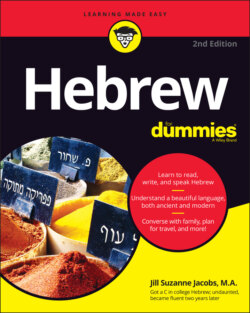Читать книгу Hebrew For Dummies - Jill Suzanne Jacobs - Страница 32
The Nitty-Gritty: Basic Hebrew Grammar
ОглавлениеIN THIS CHAPTER
Stringing words together into sentences
Getting up close with nouns and adjectives
Looking at personal pronouns
Peeling back the layers of Hebrew verbs and adverbs
Making room for prepositions
By birth, Hebrew is part of the Semitic family, along with Arabic, Aramaic, and some other Middle Eastern languages. To this day, Hebrew is quite similar to other Semitic languages in terms of the way words — especially verbs — are formed. Hebrew nouns and verbs are marked for gender (feminine or masculine, no neuter), just like their Semitic cousins.
Today, Hebrew, like many world languages, is grappling with inclusivity of nonbinary gender identities and the ways that language can acknowledge and accommodate them. In Israel, nonbinary people often speaking in alternating gender conjugations and there is no “singular they” as “they” is gendered in Hebrew. In the Diaspora, the Nonbinary Hebrew project has proposed a way for Hebrew to accommodate nonbinary gender identities, though their proposal has not (yet?) caught on in Israel or worldwide. For a chart of nonbinary Hebrew grammar and systematics, check out the Nonbinary Hebrew Project at www.nonbinaryhebrew.com/grammar-systematics.
The people who revived Hebrew as a modern language in the 19th and 20th centuries spoke and thought mostly in Yiddish, Russian, German, and other European languages. Those languages became the “adoptive parents” of Hebrew today. You notice their influence most strongly in the pronunciation of modern Hebrew and in the word order within sentences (syntax).
